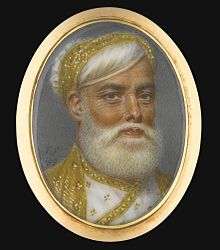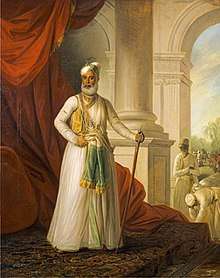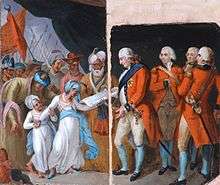Muhammad Ali Khan Wallajah
Muhammad Ali Khan Wallajah, or Muhammed Ali, Wallajah (7 July 1717 – 13 October 1795), was the Nawab of Arcot in India and an ally of the British East India Company. Muhammad Ali Khan Wallajah was born to Anwaruddin Muhammed Khan, by his second wife, Fakhr un-nisa Begum Sahiba, a niece of Sayyid Ali Khan Safavi ul-Mosawi of Persia, sometime Naib suba of Trichonopoly, on 7 July 1717 at Delhi. Muhammed Ali Khan Wallajah the Nawab of Arcot often referred to himself as the Subedar of the Carnatic in his letters and correspondence with the then Mughal Emperor Shah Alam II.
Muhammad Ali Khan Walla Jah | |
|---|---|
| Nawab of the Carnatic Amir ul-Hind Walla Jah Umdat ul-Mulk Asaf ud-Daula | |
 Muhammad Ali Khan Walla Jah | |
| Reign | 1749–1795 |
| Predecessor | Anwaruddin Khan |
| Successor | Umdat ul-Umara |
| Full name
Muhammad 'Ali Anwar ud-din Khan | |
| Born | 7 July 1717 Delhi, Mughal India (now India) |
| Died | 13 October 1795 (aged 78) Madras, India |
| Buried | Outside the gate of the Gunbad of Shah Chand Mastan, Trichinopoly |
| Noble family | Walla Jah dynasty (Anwariyya Dynasty) |
| Issue | |
| Father | Anwaruddin Khan |
| Religion | Islam |
| Military career | |
| Allegiance | |
| Service/ | Nawab of the Carnatic |
| Rank | Subedar |
| Battles/wars | Mughal-Maratha Wars, Seven Years' War, Carnatic Wars, Anglo-Mysore Wars |
Official name
His official name was Amir ul Hind, Walla Jah, 'Umdat ul-Mulk, Asaf ud-Daula, Nawab Muhammad 'Ali Anwar ud-din Khan Bahadur, Zafar Jang, Sipah-Salar, Sahib us-Saif wal-qalam Mudabbir-i-Umur-i-'Alam Farzand-i-'Aziz-az Jan, Biradarbi Jan-barabar [Nawab Jannat Aramgah], Subadar of the Carnatic.
Life

Muhammad Ali Khan Wallajah was granted the titles of "Siraj ud-Daula", Anwar ud-din Khan Bahadur, and Dilawar Jang, together with the Subadarship of the Carnatic Payeen Ghaut and a mensab of 5,000 zat and 5,000 sowar, the Mahi Maratib, Naubat, etc. by Imperial firman on 5 April 1750.
He joined forces with Nasir Jung and the British in opposing Chanda Sahib, the French nominee for the Subadarship. He was defeated by the French at Gingee in December 1750, and fled to Trichnopoly for a second time. He received an Imperial firman confirming his possession of the Carnatic and appointing him as Naib to Viceroy of the Deccan, 21 January 1751.
Raised to the titles of Walla Jah and Sahib us-Saif wal-qalam Mudabbir-i-Umur-i-'Alam Farzand-i-'Aziz-az Jan by Emperor Shah Alam II in 1760, he was recognised by the Treaty of Paris as an independent ruler in 1763 and by the Emperor of Delhi 26 August 1765.
Sir John Macpherson, writing to Lord Macartney in November 1781 declared, "I love the old man...mind me to my old Nabob. I have been sending him sheep and bags of rice by every ship. It is more than he did for me when I was fighting his battles."
The Nawab was an ally of the British East India Company, but also harboured great ambitions of power in the South Indian arena, where Hyder Ali of the Mysore, the Marathas, and the Nizam of Hyderabad were constant rivals. The Nawab could also be unpredictable and devious, and his breach of promise in failing to surrender Tiruchirappalli to Hyder Ali in 1751 was at the root of many confrontations between Hyder Ali and the British.
When Hyder Ali swept into the Carnatic towards Arcot on 23 July 1780, with an army estimated at 86–100,000 men, it was not the Nawab, however, but the British who had provoked Hyder Ali's wrath, by seizing the French port of Mahé which was under his protection. Much of the ensuing war was fought on the Nawab's territory.

For the defence of his territory, the Nawab paid the British 400,000 pagodas per annum (about £160,000) and 10 out of the 21 battalions of the Madras army were posted to garrison his forts. The British derived income from his jagirs (land grants).[1]
Political influence
For a period the situation of the Nawab was a significant factor in Westminster politics. The Nawab had borrowed heavily; and many East India Company officials, in India or in the United Kingdom, were his creditors. Elections in the UK could be, and were, influenced by nabob money, with the result that a group of about a dozen Members of Parliament formed a discernible "Arcot interest", as it was called.
By the 1780s issues affecting Arcot were therefore having a direct impact on British politics: the debts of the Nawab mattered in domestic terms.[2]
Death
He died from gangrene poisoning, at Madras on 13 October 1795. He was buried outside the gate of the Gunbad of Shah Chand Mastan, Trichinopoly.
He was succeeded by his son Umdat ul-Umara, who was later accused of supporting Tipu Sultan the heir of Hyder Ali during the Fourth Anglo-Mysore War.
See also
- Nawabs of Arcot
Notes
| Wikimedia Commons has media related to Muhammad Ali Khan Wallajah. |
- "The Tiger and The Thistle – Tipu Sultan and the Scots in India". Natgalscot.ac.uk. Archived from the original on 11 August 2006. Retrieved 17 January 2013.
- Partha Chatterjee (5 April 2012). The Black Hole of Empire: History of a Global Practice of Power. Princeton University Press. p. 56. ISBN 978-1-4008-4260-5. Retrieved 20 April 2012.
| Preceded by Chanda Sahib |
Nawab of Carnatic (de facto) (Confirmed by Carnatic Treaty of 1754) 1752 – 13 October 1795 |
Succeeded by Umdat ul-Umara |
| Preceded by Anwaruddin Khan |
Nawab of Carnatic (de jure) (Confirmed by 1763 Treaty of Paris) 3 August 1749 – 13 October 1795 |